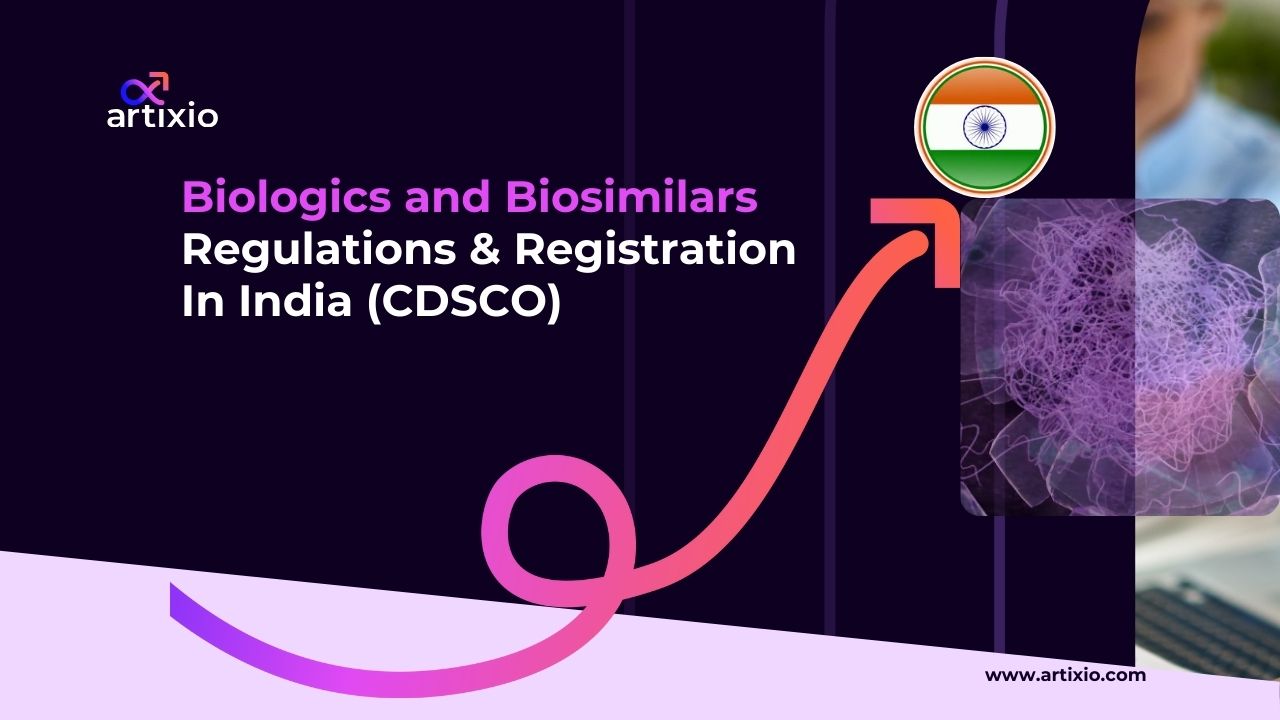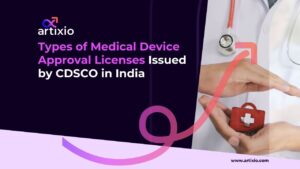- The size of the Indian biosimilars market, which was anticipated to be worth $349 million in 2022, is expected to increase to $2108 million in 2030 at a compound annual growth rate (CAGR) of 25.2%.
- The Indian government introduced the Biotechnology Industry Partnership Program (BIPP) in 2016 to help small and medium-sized biotech companies produce biosimilars.
This article outlines the Biologics and Biosimilars regulations and registration in India (CDSCO)
Biologics and Biosimilars Regulation and Registration in India (CDSCO)
Biologics are complex therapeutic products that are derived from living organisms or contain living organisms, such as proteins, nucleic acids, and cells. Biosimilars are products that are highly similar to an approved reference biologic product, with no clinically meaningful differences in terms of safety, efficacy, and quality.
Biologics and Biosimilars Regulatory Authority in India
In India, the regulations and registration framework for biologics and biosimilars falls under the purview of the Central Drugs Standard Control Organization (CDSCO), which operates under the Ministry of Health and Family Welfare.
Regulatory Framework for Biosimilars and Biologics in India
India has a definitive regulatory framework for the marketing authorization of biosimilar medicines. The Drugs & Cosmetics Act of 1940 and the Drugs & Cosmetics Rules of 1945 (collectively, “D&C Rules”), which were created in accordance with the D&C Act, control the clinical trial, importation, and manufacturing processes for all medications, including biologics and biosimilars, in India.
Patentability: The Patents Act, 1970 (“Patents Act”), India’s patent regulatory framework, excludes the discovery of a new use for a known substance from the definition of invention, hence India does not recognize second medical use patents.
Biologics and Biosimilars Clinical Trials Requirements
- Under the D&C Act, New Drugs & Clinical Trial Rules, 2019 (“New Drugs & CT Rules”) set forth the process for carrying out clinical trials for all medications, including biologics and biosimilars.
- In India, generic medications and biosimilar medications are not subject to the same regulations. Although both generic pharmaceuticals and biosimilars fall under the Pharmaceuticals & Cosmetics Act 1940 (“D&C Act”), which is India’s main drug control law, the clinical trial standards for biosimilars are tighter than those that apply to generic drugs.
- Biosimilar applicants need to provide a comprehensive set of data, including comparative analytical data, non-clinical data, and clinical data, to establish the bio-similarity of the product. The extent of clinical trials required can vary based on the nature of the product and the data available
- Approval Process and Regulatory Authority: Clinical trials for biologics and biosimilars in India must receive approval from the CDSCO. The process involves submitting an application detailing the trial protocol, investigational product information, patient recruitment criteria, and safety monitoring procedures.
- Clinical Trial Phases: Clinical trials typically progress through several phases:
Phase 1: Focuses on safety and dosage determination in a small number of healthy volunteers.
Phase 2: Involves a larger group of patients to assess safety, efficacy, and dosage range.
Phase 3: Encompasses a larger patient population to further assess efficacy, monitor side effects, and compare the treatment to standard therapies or placebos.
- Data Requirements: Clinical trial applicants must provide comprehensive data on the biologic or biosimilar, including its manufacturing process, quality controls, safety data from preclinical studies, and data from clinical trials conducted in other countries if available.
- Comparative Clinical Trials for Biosimilars: For biosimilars, comparative clinical trials are often required to demonstrate equivalence or similarity to the reference biologic. These trials compare the biosimilar to the reference product in terms of safety, efficacy, and immunogenicity.
- Patient Recruitment and Informed Consent: Ethical considerations are paramount. Patients must provide informed consent before participating in a clinical trial. Informed consent includes detailed information about the trial, its objectives, potential risks, and benefits.
- Ethics Committees: All clinical trials must be reviewed and approved by an independent ethics committee (institutional review board) to ensure that the trial is scientifically sound and ethically conducted.
- Safety Reporting: Clinical trials require vigilant monitoring of participants’ safety. Adverse events and unexpected reactions must be reported to the regulatory authority and ethics committee promptly.
- Post-Trial Reporting: After the trial is completed, the results must be reported to the CDSCO and published in scientific literature, regardless of whether the outcomes are positive or negative.
- Data Integrity and Good Clinical Practice (GCP): Trials must adhere to principles of Good Clinical Practice, ensuring the reliability and integrity of trial data.
- Quality Control and Documentation: Rigorous quality control measures must be implemented in terms of manufacturing, labeling, packaging, and storing of investigational products.
Important Documents
Clinical Trial Protocols and Reports: Detailed protocols for preclinical and clinical studies, including the proposed study design, patient population, endpoints, and statistical methods. Comprehensive reports on the results of preclinical and clinical studies, including safety and efficacy data.
Comparability Data (for Biosimilars): Comparative analytical data that demonstrate the similarity between the biosimilar and the reference biologic. Non-clinical data comparing the biosimilar and the reference product.
Quality Information:
- Detailed information about the manufacturing process, including the cell lines used, fermentation, purification, and quality control methods.
- Specifications for the final product, including identity, purity, potency, and impurity profiles.
- Description of the quality control tests and methods used to ensure consistency and quality.
Stability Data: Data demonstrating the stability of the product under various storage conditions over its expected shelf life.
Pharmacovigilance Plan and Post-Marketing Surveillance Data:
- Plans for monitoring the safety of the product after it is approved and marketed.
- Data from post-marketing surveillance, including adverse event reports and safety updates.
Labeling and Package Insert:
- Drafts of the product labeling, including the package insert, prescribing information, and patient information leaflet.
- Indication and Dosage Information:
- Detailed information about the intended indications for use and recommended dosages.
- Summary of Product Characteristics (SmPC):
- A comprehensive document providing detailed information about the product’s characteristics, indications, contraindications, warnings, precautions, and more.
Risk Management Plans (if required): Plans outlining strategies for managing and minimizing known or potential risks associated with the product.
Authorization Letter from Manufacturer: A letter from the manufacturer authorizing the submission of the application and providing contact details for communication.
Letter of Commitment: A commitment from the applicant to adhere to post-marketing requirements, including submitting safety updates and conducting post-marketing studies if necessary.
Other Regulatory Documents: Any other documents required by the regulatory authority, such as forms, declarations, or certifications.
Approval Process for Biosimilars:
Comparability Studies: To seek approval for a biosimilar, the manufacturer must conduct extensive comparability studies to demonstrate that the biosimilar is highly similar to the reference biologic in terms of quality, safety, and efficacy. These studies include analytical, non-clinical, and clinical data.
Analytical Data: The manufacturer must provide comprehensive analytical data showing the similarity of the biosimilar and the reference biologic in terms of molecular structure, post-translational modifications, and other relevant characteristics.
Non-Clinical Data: Non-clinical studies are conducted to assess the biosimilar’s safety and pharmacological properties. These studies help identify any potential differences between the biosimilar and the reference product.
Clinical Data: Depending on the specific requirements of the regulatory authorities, clinical studies may be necessary to demonstrate the biosimilar’s safety, efficacy, and immunogenicity. These trials compare the biosimilar to the reference biologic in terms of therapeutic response and adverse events.
Extrapolation: In certain cases, approval for additional indications beyond those studied in clinical trials may be granted through a process known as extrapolation. This allows the biosimilar to be approved for indications not directly tested in clinical trials based on the understanding of the mechanism of action and available clinical data.
Labeling and Packaging: Biosimilars are required to have clear labeling that identifies them as biosimilars and provides information about the reference product.
Approval Process for Biologics:
Clinical Trials: Biologics are complex therapeutic products derived from living organisms. The approval process for novel biologics involves conducting comprehensive preclinical and clinical trials to establish their safety and efficacy.
Investigational New Drug (IND) Application: Before conducting clinical trials, the manufacturer must submit an IND application to the regulatory authority. This application includes preclinical data, manufacturing information, and the proposed clinical trial protocol.
Clinical Trials: Clinical trials for biologics follow a phased approach (Phase 1, Phase 2, and Phase 3), where safety, dosing, efficacy, and side effects are assessed in increasing numbers of participants.
New Drug Application (NDA): Once clinical trials are completed, the manufacturer submits an NDA containing comprehensive data on the biologic, including its manufacturing process, preclinical and clinical data, and information on safety and efficacy.
Review and Approval: The regulatory authority reviews the NDA and associated data to determine whether the biologic should be approved for marketing. This process involves a thorough evaluation of the product’s safety, efficacy, and quality.
Post Marketing Surveillance
The general principles and processes involved in post-marketing surveillance of biologics and biosimilars in India:
Adverse Event Reporting: Manufacturers, healthcare professionals, and patients are encouraged to report any adverse events or side effects associated with biologics and biosimilars to the regulatory authorities. This information helps monitor the safety profile of these products.
Pharmacovigilance Program: The CDSCO oversees a pharmacovigilance program to collect, collate, and analyze adverse event data. This program involves establishing a robust system for collecting adverse event reports from various sources. Once the biosimilar has been approved, PSURs must be filed to the CDSCO every six months for the following two years. The PSUR must then be submitted every year for the following two years.
Adverse Event Reporting System: A system for reporting adverse events, often called the Adverse Drug Reaction (ADR) reporting system, is used to gather information on unexpected or adverse effects of biologics and biosimilars.
Signal Detection: Regulatory authorities use advanced data analysis techniques to identify potential signals of safety concerns. If a signal is detected, further investigation and action may be taken.
Risk Management Plans (RMPs): Manufacturers of high-risk biologics and biosimilars may be required to submit Risk Management Plans to the regulatory authorities. These plans outline strategies to minimize known or potential risks.
Labeling Updates: If new safety information arises, regulatory authorities may require updates to the product labeling, including package inserts and prescribing information, to inform healthcare professionals and patients about the potential risks.
Communication: Regular communication between regulatory authorities, healthcare professionals, and manufacturers is essential for effective post-marketing surveillance. Information about safety concerns and updates is shared to ensure appropriate actions are taken.
Collaboration with Global Authorities: In an interconnected world, regulatory authorities often collaborate with their counterparts in other countries to share information and insights regarding the safety of biologics and biosimilars.
Product Withdrawal or Suspension: In cases where serious safety concerns are identified, regulatory authorities have the authority to withdraw or suspend the marketing authorization of a biologic or biosimilar.
Continuous Monitoring: Post-marketing surveillance is an ongoing process, and regulatory authorities continuously monitor safety data throughout the product’s lifecycle.
Reference
- https://cdsco.gov.in/opencms/resources/UploadCDSCOWeb/2018/UploadAlertsFiles/BiosimilarGuideline2016.pdf





